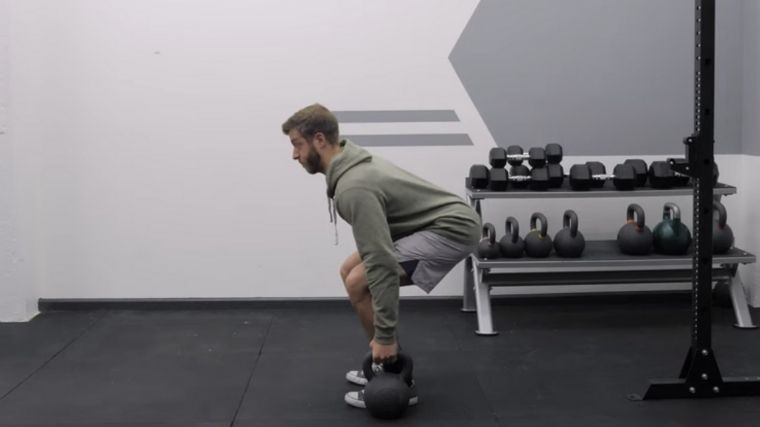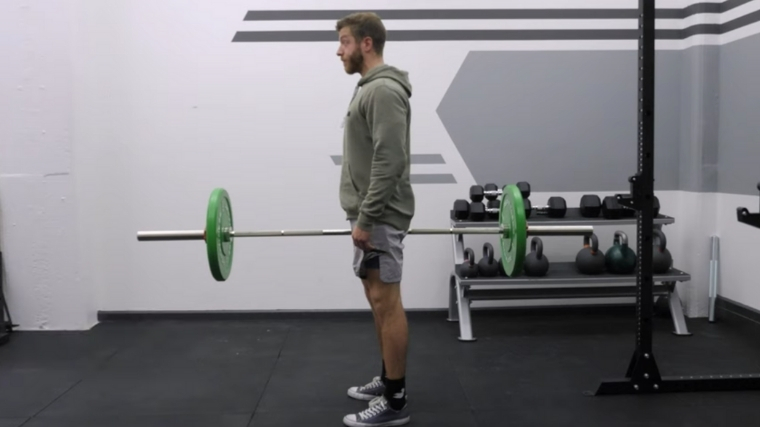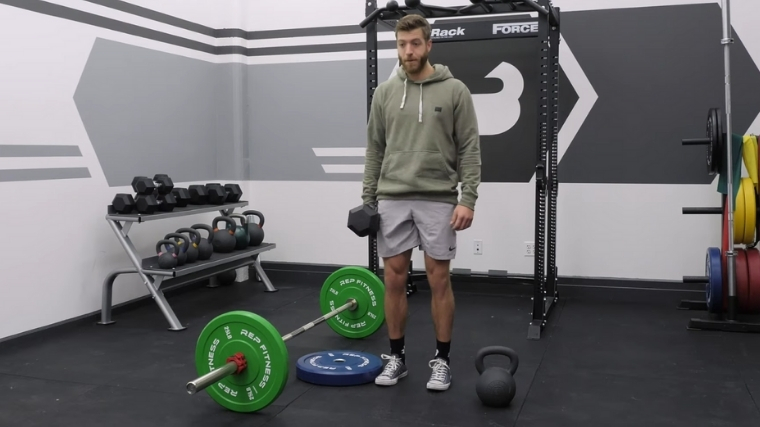The suitcase deadlift — where you perform a deadlift with one side of your body loaded — is more useful than you may think. First, think about how often you carry something in one hand, be it a bag of groceries, a backpack, or even a weight plate in the gym. For that reason alone, the suitcase deadlift can help you perform everyday tasks better. Also, deadlifting a single weight builds a lot of core strength, enhances your grip, and reinforces proper hip hinge positioning. Don’t sleep on the suitcase deadlift.
That said, we realize you’re probably not going to lead off your training days with this exercise. Below, we’ll teach you how to do the suitcase deadlift, program it, and variations of the movement you can try.
- How to Do the Suitcase Deadlift
- Benefits of the Suitcase Deadlift
- Muscles Worked by the Suitcase Deadlift
- Who Should Do the Suitcase Deadlift
- Suitcase Deadlift Sets, Reps, and Programming Recommendations
- Suitcase Deadlift Variations
- Suitcase Deadlift Alternatives
- Frequently Asked Questions
Suitcase Deadlift Video Guide
Check out the video tutorial on the suitcase deadlift below, led by BarBend‘s former Training Editor Jake Boly.
How to Do the Suitcase Deadlift
Below is a step-by-step guide on how to properly set up and perform the suitcase deadlift. Note: The suitcase deadlift is often done with one weight only. If you add another kettlebell or dumbbell into the mix, then you’re doing a dumbbell or kettlebell deadlift.
Step 1 — Grip and Set the Back
Stand tall next to a kettlebell set to one side of your body. (You can also use a loaded barbell or a dumbbell, which you should rest on a bumper plate to reduce the distance you need to travel to pick it up.) Assume your standard deadlift stance and drive your hips back to hinge forward, and grab the kettlebell.
Form Tip: Squeeze your shoulder blades together and back to really tighten your back. Having a tight (or set) back will help prevent unwanted torso twisting mid-lift. This is a crucial step during the suitcase deadlift and any unilateral exercise, really.
Form Tip: Step 2 — Stand Up
Drie your hips forward to stand up. Do your best not to let your torso twist or overly extend to one side. You should feel your core working a good deal during this phase of the exercise.
From Tip: It is helpful to actively keep the weight off the sides of the hips by lifting them outwards about one inch away from the body (this will also activate the back muscles). You can have your unweighted hand out in front of you for a counterbalance.
Step 3 — Lower Under Control
With the feet about hip-width and toes forward, push the hips back and down, maintaining a flat back. As you approach the bottom of the deadlift, keep the chest high and core tight. This will ensure your lower back and torso are stable.
From Tip: The weight should stay in line with the center of the foot. Be careful not to let the chest and shoulders collapse forward.
Benefits of the Suitcase Deadlift
Suitcase deadlifts offer coaches and athletes many of the same benefits as conventional, sumo, and trap bar deadlifts. With that said, the below benefits are specific to the suitcase deadlift.
More Grip Strength
Grip is a limiting factor in strength sports. If you struggle with grip issues, the suitcase deadlift can help highlight which of your hands are weaker than the other so you can hone in on them. Also, gripping any heavy object as you perform high-rep suitcase deadlifts will help boost your ability to hold onto things for longer.
Improved Hip Hinge Mechanics
If you’re brand new to the deadlift, the thing can be troublesome at times, especially when you’re trying to maintain a nice and neutral torso. The suitcase deadlift is a great exercise to reinforce a proper hip hinge because you’ll feel the urge to hike one hip up at a time (due to the single-sided load).
More Muscular Development
Like a standard deadlift, the suitcase deadlift will work your lower back, hamstring, and glute muscles. Compared to the standard deadlift, your core will be far more active during the suitcase variation. Because you’re lifting with one side of your body loaded, your core will need to brace extra hard to keep your torso stable and straight. Of course, that’s true during any lift, but to a far lesser degree.
Muscles Worked By the Suitcase Deadlift
The suitcase deadlift is a hinging movement that targets the lower body and stabilizer. Here are the major muscles affected by the suitcase deadlift.
Hamstrings
The hamstrings are primary movers in the suitcase deadlift. However, due to the lifter using a lower hip positioning in the pull (unless purposefully done with high hips), some work shifts from the hamstrings to the quadriceps.
Quadriceps
The quadriceps help to extend the knees and provide stability as the hamstrings work to extend the hips. Both muscles are active. However, the more vertical the lifter can keep their torso, the lower the hips will be. This will result in the quadriceps becoming more involved than in a Romanian deadlift or stiff-legged deadlift variation.
Latissimus Dorsi (Back)
The back muscles contract to help stabilize the spine as the lifter is in the bent-over position. Unlike the barbell deadlift, the suitcase deadlift forces a lifter to contract the lats and set the back to resist the loads from twisting the torso.
Glutes
The glutes work to extend the hips and stabilize the lifter as they descend into the deadlift. Much like during barbell deadlifts, squats, and reverse lunges, the glutes are a primary muscle group involved in this lower body exercise.
Core Muscles
The suitcase deadlift is challenging on the core muscles as they must resist any rotational forces due to the asymmetrical loading of this movement. When done with one weight, the core demands are much higher.
Spinal Erectors
The spinal erectors (lower back) work to resist forward flexion of the spine in the suitcase deadlift.
Who Should Do the Suitcase Deadlift?
The below section breaks down the benefits of the suitcase deadlift based on a lifter’s and athlete’s sport goals and abilities.
[Read More: The Best Ab Exercises & Workouts, According to a CPT]
Strength and Power Athletes
- Powerlifters and Strongmen/Strongwomen: The deadlift is a must-do movement for powerlifters and strongman athletes. That said, we wouldn’t make the suitcase deadlift an entree in your training. Strength athletes need to focus on strength, and so moving the most weight possible. If anything, you can use the suitcase deadlift as a core exercise and to warm up and prime your deadlift muscles before a heavy training session.
- Olympic Weightlifters: The suitcase deadlift has an even less specific carryover to Olympic weightlifting, but it’s a good core exercise to improve anti-rotational strength.
Fitness Athletes
Fitness athletes, such as CrossFitters, need muscle mass, grip strength, and core strength. The suitcase deadlift can build all of those traits. Also, many fitness competitions utilize single-dumbbell movements, such as dumbbell snatches, so doing suitcase deadlifts with a single dumbbell can build proficiency with unilateral movements.
General Population
Anyone who trains can reap the benefits listed above from doing the suitcase deadlift.
Suitcase Deadlift Sets, Reps, and Programming Recommendations
Whether you want to gain muscle or boost your conditioning, here are two ways to program suitcase deadlifts into your routine. Note: The suitcase deadlift isn’t the best option for getting strong. For that, focus on other deadlift variations such as sumo, conventional, and trap bar.
To Gain Muscle
If your goal is muscle hypertrophy, you want to focus on using a moderate load with a controlled tempo. Start by performing two to three sets of eight to 12 repetitions with moderate loads. Rest for 45-90 seconds between sets.
To Improve Muscle Endurance
Some lifters may want to train greater muscle endurance (for sport), in which higher repetition ranges and/or shorter rest periods are recommended. Start by doing two to three sets of 15-20 repetitions with 45-60 second rest with light to moderate loads.
Suitcase Deadlift Variations
Below are two suitcase deadlift variations that coaches and athletes can use to keep training varied and progressive.
Deficit Suitcase Deadlift
The deficit deadlift inherently places the lifter in deeper knee and hip flexion angles than a normal barbell deadlift due to the placement and size of the loads relative to the clearance on the floor. Coaches can perform deficit suitcase deadlifts to fully challenge and develop the lower back, legs, and back muscles and reinforce strong, functional movement. Lastly, the deficit suitcase deadlift can be done to increase glute, quad, and back strength.
[Read More: Best Lower Back Exercises for Strength and Reduced Pain]
Tempo Suitcase Deadlift
This is simply the suitcase deadlift but done for a set tempo — for example, three seconds down, a two-second pause, and three seconds up. Tempo training is great for developing muscle mass (time under tension), body control, and enhancing positional integrity of the moment throughout various phases of the deadlift.
Suitcase Deadlift Alternatives
Below are two suitcase deadlift alternatives coaches and athletes can use to increase overall leg strength, address weaknesses, and build muscle.
Trap Bar Deadlift
The trap bar deadlift allows for optimal positioning since you’re centered within the load. Also, your wrists are in a neutral position, allowing you to lift more weight.
Deficit Conventional Deadlift
The deficit conventional deadlift also referred to as a barbell deadlift, is done by standing on blocks, bumper plates, or another elevated surface. By performing the deadlift from a deficit, the lifter must lift through an extended range of motion for more tension and pulling strength from the floor.
FAQs
How heavy should you lift with the suitcase deadlift?
Not that heavy. Of course, heavy is relative, but compared to barbell deadlift variations, you won’t lift that heavy with this movement. That said, depending on whether you want to lift for more muscle or endurance, you’ll use a heavier or lighter load, relatively speaking.
Who should not do suitcase deadlifts?
If you have a history of back injury, this lift can cause a lot of torsion which may harm the area. Of course, always consult with a doctor before altering your training program.
Are suitcase deadlifts functional?
Yes. Often in life, we need to lift an object from a low point and get it to our side, our shoulder, or onto something else. Being able to have the core strength, ability to resist lateral flexion under load, and coordination to do suitcase deadlifts can help in daily life (traveling, manual labor, lifting groceries, playing or lifting kids, etc).



